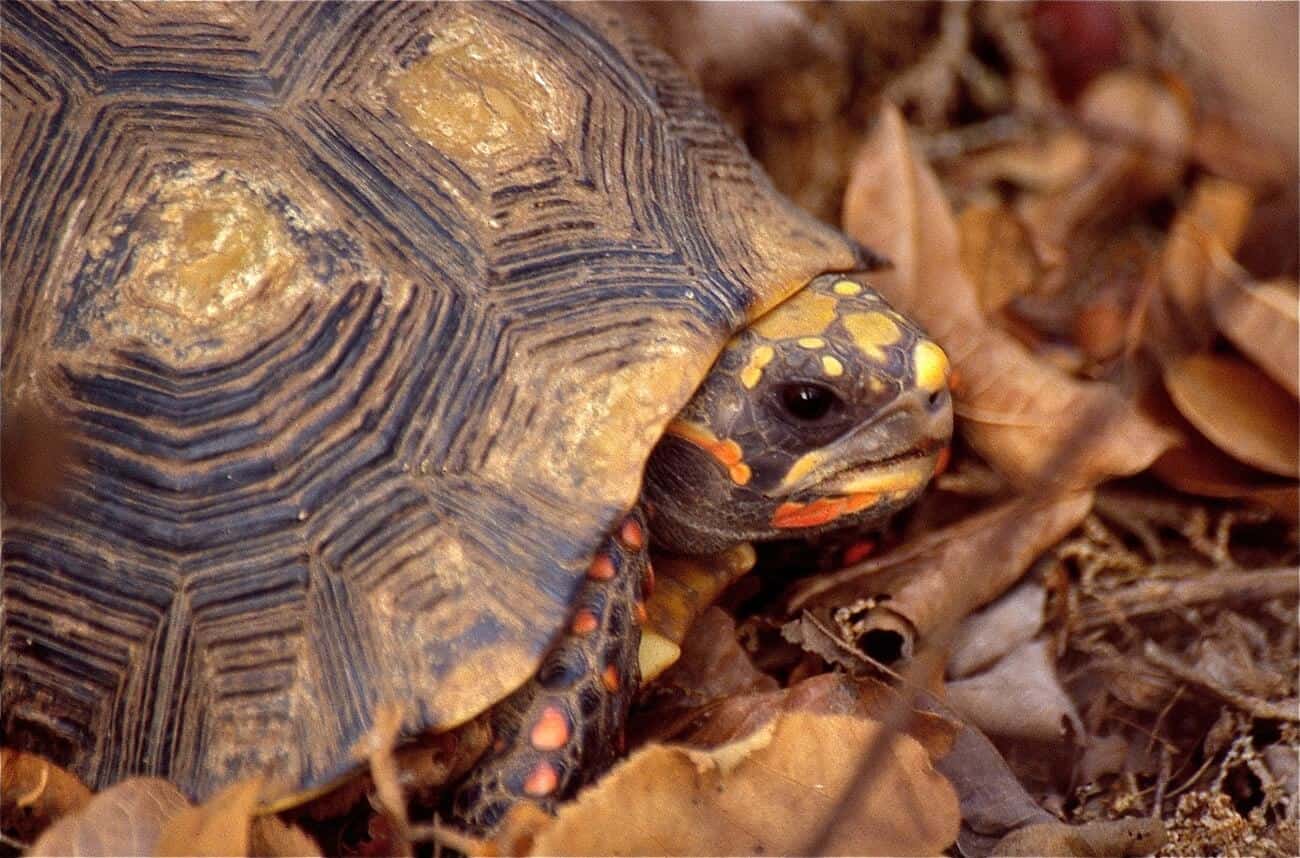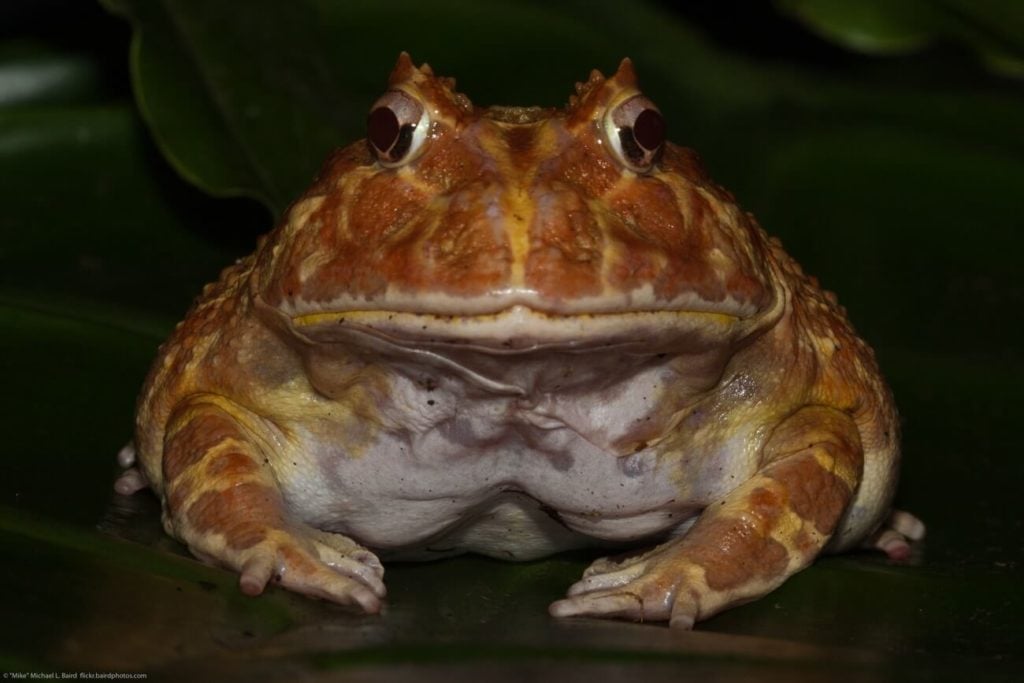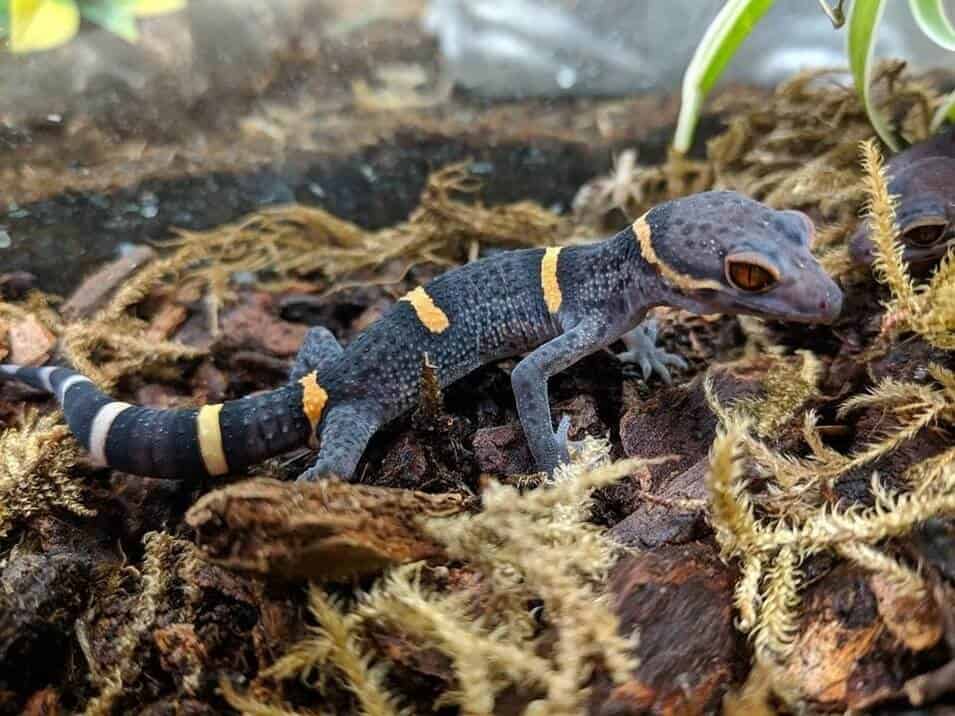Red-footed tortoises are a wonderful pet that have steadily gotten more popular over the years. And the more you learn about them, it’s not hard to see why!
These reptiles are low-maintenance, beautiful, and fairly active (for a tortoise at least). We’ve been a huge fan of this species for quite some time and recommend them to other reptile-lovers all the time.
This detailed guide will go over every important piece of red-footed tortoise care that you’ll need to know. We cover diet, habitat, size, lifespan, and plenty of other useful facts!
Table of Contents
Species Summary
Named for the brightly colored scales on their legs, the red-footed tortoise (Chelonoidis carbonarius) is a beautiful reptile that flourishes in captivity. They have an easy-going temperament and are more active throughout the day than other tortoise species, making them a joy to watch!
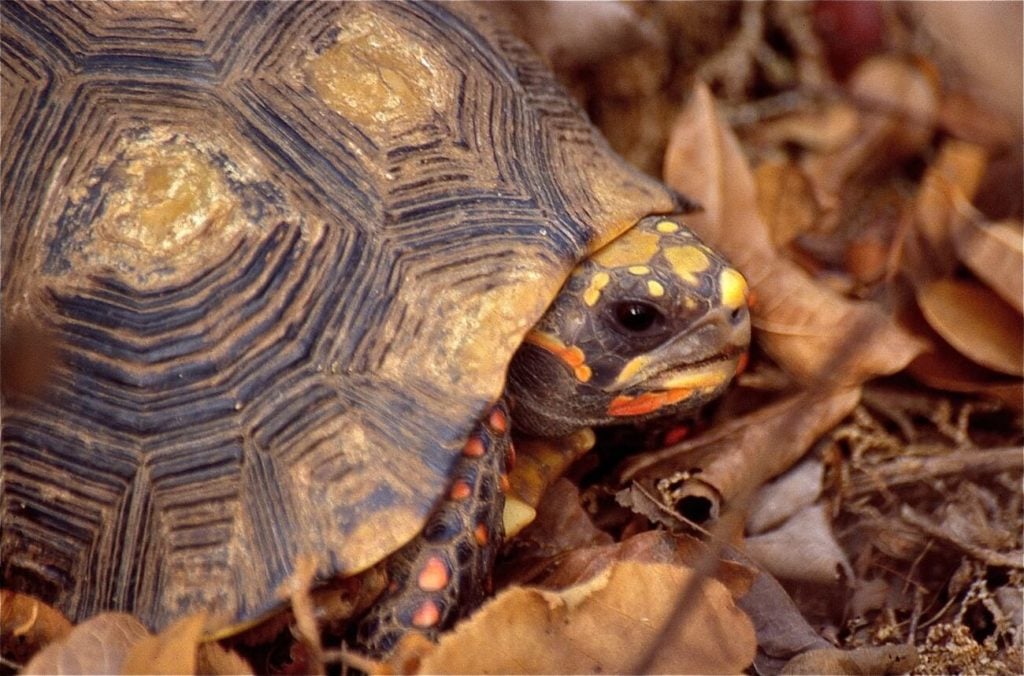
In the wild, red-footed tortoises are endemic to several regions throughout Central and South America. They can inhabit a range of environments, including dry savannahs and wet forests.
These tortoises are quite popular in the reptile trade. Thanks to their docile nature and relatively easy care requirements, they’re a low-maintenance pet tortoise that can be with you for decades!
Lifespan
The average red-footed tortoise lifespan is between 30 and 50 years in captivity. This assumes they’re living in a well-maintained environment.
The life expectancy of a red-footed tortoise is heavily impacted by the care they receive. While some uncontrollable factors could have an effect, their overall health and well-being are largely dependent on you. Failing to meet their needs could result in disease and a potentially death.
Appearance & Colors
Red-footed tortoises are beautiful creatures that are pretty easy to identify. Just take a look at their legs! Like other tortoises, the legs and body are covered in thick armor-like scales.
Most of the scales are dark brown, black, or gray. However, more vibrant scales peak through to add a pop of gorgeous color. Most often, these colorful scales take on shades of red. However, you might also see orange or yellow depending on the regional varieties.
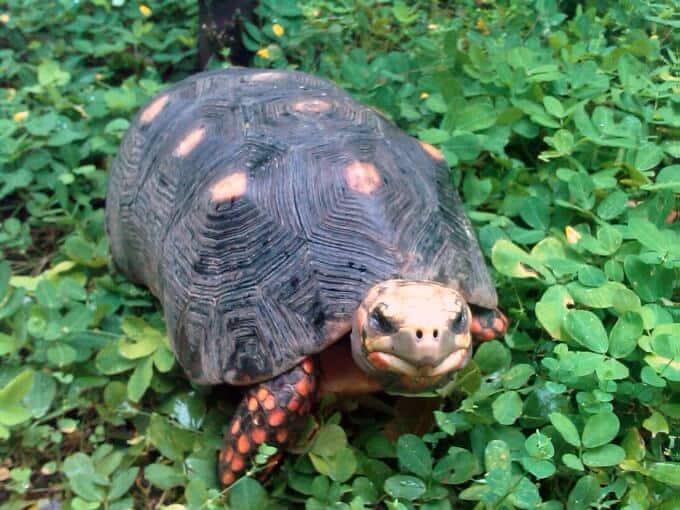
Their shells are eye-catching, too. They have a loaf-shaped carapace. Each scute typically has a dark brown, black, or gray perimeter. Typically though, the raised center is significantly lighter( usually it’s a pale yellow). This color combination creates a stunning three-dimensional look!
These tortoises have a squared-off head with a flat top. Their faces may be a bit lighter, making their strong beaks more visible. You may also see some brighter patches of skin with the same coloration as the scales on their legs.
Expert Tip: Some sexual dimorphic traits do exist, but they are subtle. The easiest way to tell the difference between males and females is by analyzing the tail and plastron.
Males have a long and muscular tail. The plastron has a deep indentation around the tail, which undoubtedly helps with mating. The tail on the female is more conical. The plastron is also shallower, but it offers more protection to the tortoise’s rear end.
Average Size
The typical red-footed tortoise size can range from roughly 10 inches to 16 inches when fully grown. On rare occasions, some tortoises will even reach lengths of 18 inches! The average weight of an adult red-foot is about 30 pounds.
Generally, males are larger than females. However, females don’t lag behind too much in terms of growth and size. Both have a fairly average growth rate for a tortoise.
Red-Footed Tortoise Care
Most owners will tell you that red-footed tortoise care is a piece of cake. For the most part, it’s not difficult at all! However, you have to invest some time initially to create the perfect habitat and care schedule. That’s where you can’t coast.
Luckily, once you establish a routine and understand what these tortoises need, it’s smooth sailing moving forward.
Here are the most important care guidelines to keep your red-footed tortoise happy and healthy.
Enclosure Size
One of the most important things to establish early on is the right enclosure. These tortoises can live indoors, but they will need a large home.
Indoor enclosures should measure at least 48 inches long by about 72 inches wide. You can keep them in a decorated vivarium or a tortoise table if your home stays warm.
However, If you live in a warm climate it’s better to keep them in an outdoor enclosure. This outdoor enclosure should measure at least 48 inches long by 96 inches wide (but bigger is always better for these active reptiles).
When keeping them outside it’s important to create a predator-proof and escape-proof environment. This means creating thick, unclimbable walls that extend at least a foot into the soil to prevent digging. The walls should be at least 16 inches high.
Expert Tip: You will definitely want to utilize a screened top if there are natural predators in your area (there usually are).
Habitat Setup
Whether you create your tortoise’s new home indoors or out, there are several items you need to include in their habitat setup.
The first is a suitable substrate. Red-footed tortoises are powerful diggers and like to burrow for safety and solace from the sun.
You can use cypress bark, orchid bark, sphagnum moss, coconut coir, or an additive-free topsoil mix. Soil and sand mixtures work well, too. All of these substrates are diggable and hold onto moisture to keep humidity levels high.
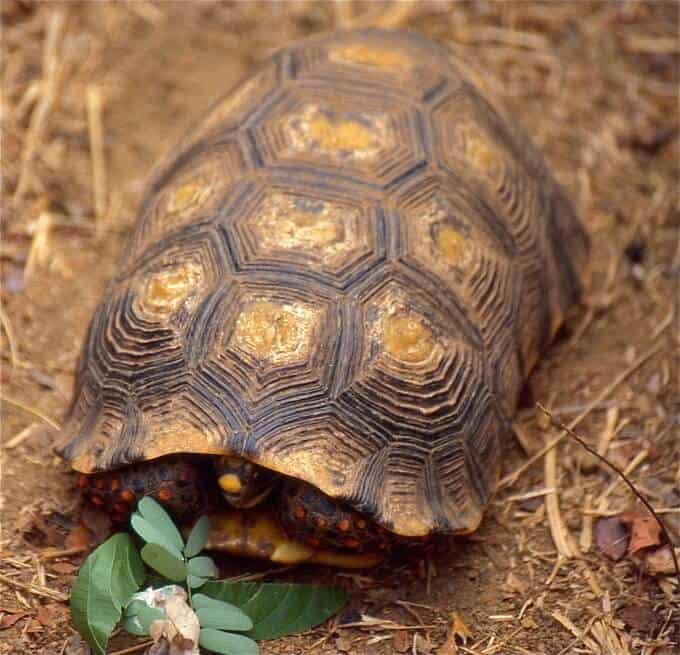
Live or artificial plants are great additions to the enclosure as well. They provide some shade and can help with humidity levels.
There are no major requirements in terms of plant species, but try to stick with plants the tortoise would normally eat (here’s a great resource to get you started). Avoid anything that’s potentially dangerous or toxic.
Finally, add a small shelter. In the wild, red-footed tortoises will often wedge themselves between roots. If the space is big enough, they will even share the confined space with others!
You can create this by adding an appropriately sized hide box. It can be made from wood or molded plastic. Make sure that the box is big enough for the tortoise to get in and turn. But other than that, keep it relatively confined.
Temperature & Lighting
Red-footed tortoises are cold-blooded animals that will regulate their body temperature by moving to warm and cool areas. This means you’ll need to create a temperature gradient.
The basic ambient temperatures should be warm. The cooler side of the enclosure needs to be somewhere between 80 and 90 degrees Fahrenheit. This is the temperature that keeps the tortoise most active.
Expert Tip: These reptiles can tolerate temperatures as low as 70 degrees at night. But anything lower than that and you’ll need to install a heat emitter.
If they’re outside, you may want to consider bringing them indoors. Temperatures lower than 70 degrees put the tortoise at risk for illness.
On one side of the enclosure, create a basking spot. Temperatures in this basking area should be between 95 and 100 degrees.
Another important thing to have is a UVB light. Tortoises kept outdoors will get all of their UV rays from the sun. However, indoor tortoises need simulated UV from special lamps. Install a 10-percent UVB lamp with a reflector for adequate spread.
Humidity
High humidity levels are a must. These tortoises need an environment with 50 to 70 percent humidity. Some even prefer levels as high as 80 percent.
Invest in a hygrometer to monitor the humidity closely. Too much or too little moisture in the air could lead to health problems later on (more on that later).
The substrate material and plants you choose will help keep the humidity level high. You can also spray the enclosure down daily or invest in a misting system if you want to automate the process.
Water
A water dish will also help maintain humidity in the habitat. That said, red-footed tortoises will also use the dish to soak and get comfortable. They love a muddy wallow or puddle to rest in.
Place a large and shallow dish of water. It should be large enough for the tortoise to climb in. Avoid any deep pans that could make it difficult for the tortoise to access.
Expert Tip: Clean and refill the pan regularly. There’s a good chance that the tortoise will defecate in the dish, so cleaning it will reduce the risk of illness.
Red-Footed Tortoise Diet & Food List
Red-footed tortoises are omnivores. In the wild, they are natural-born scavengers that will eat a wide range of foods.
It’s important to create a balanced diet with a lot of variety. However, you should focus more on leafy greens and vegetables. Ideally, their diet should be split up like this:
- 60 percent dark leafy greens
- 15 percent vegetables
- 15 percent fruit
- 10 percent pellets or animal proteins
Exercise caution when it comes to protein. You can provide the occasional gut-loaded insect. Waxworms, bloodworms, mealworms, crickets, earthworms, and other insects work fine. You can even provide chopped up animal meat.
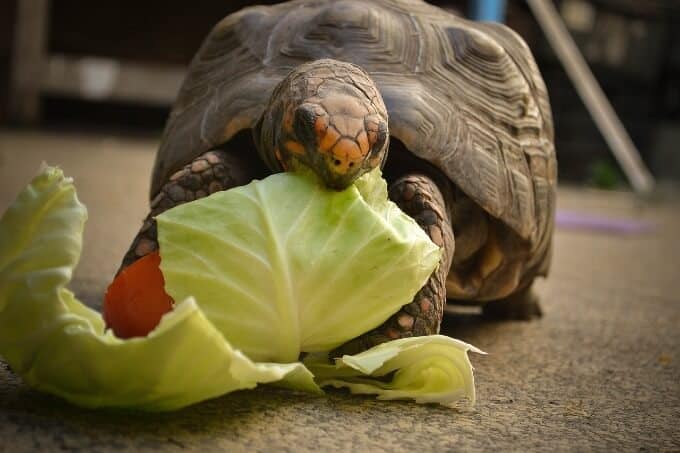
However, you must keep those high-protein food sources to a minimum. Too much could lead to neurological issues and shell diseases.
Plant-based foods are the most important thing to focus on. Using the percentage guide above, you can use some of the following foods to create a well-balanced meal.
- Turnip greens
- Spinach
- Collard greens
- Berries
- Apples
- Romaine lettuce
- Cactus fruit
- Broccoli
- Plums
- Mustard greens
- Swiss Chard
- Watercress
- Dandelion greens
- Carrots
- Grapes
- Endive
- Parsley
- Zucchini
- Papaya
- Peaches
Feed your tortoise daily and don’t provide them with more food than they can eat in 15 to 30 minutes. A good guideline that many owners use to figure out portions is matching the size of the meals to the size of the shell.
Sprinkle the food with calcium and multivitamin supplement powders about two to three times a week. For younger tortoises (less than a year old), provide those supplements daily.
Potential Health Issues
Red-footed tortoises can experience a range of diseases. However, most are easy to avoid with good enclosure maintenance and general care.
Stay on top of humidity levels, temperature, and overall cleanliness. Spot clean the enclosure daily and do heavy cleanings about once a month to keep bacteria at bay.
The most common health concerns these tortoises experience are shell rot, respiratory infection, and metabolic bone disease.
Shell rot is typically caused by bacteria or fungus. It can weaken the shell, cause flaky patches, and even lead to death if not treated. Consult a vet for treatment. Usually, antibiotics will take care of the disease.
Respiratory infections are a product of improper temperatures and humidity levels. Tortoises can experience inflammation in their respiratory system, leading to discharge, swelling, and pain.
Metabolic bone disease is a serious condition that affects tortoises without proper UV exposure. Like most reptiles, these tortoises need UV exposure to metabolize calcium. Without it, the bones and shell can become brittle. Make sure that your UV lamps are in working condition!
Expert Tip: Parasites are pretty common, too. Many tortoises have internal parasites at a young age. You can treat those early on with fecal examinations at your vet. Once they’re removed, good husbandry will prevent them from returning.
Behavior & Temperament
When you first bring your new red-footed tortoise home, they’ll likely spend most of their time in hiding. They may be a bit shy and spend a lot of time burrowing in the substrate. Be patient and give them some time!
They display this behavior when feeling stressed. Once they get comfortable with their new home, they will become far more active.
During the day, red-footed tortoises scavenge for food, burrow to get comfortable, and bask under the light. They’re more active than most tortoise species. However, they can spend a lot of time resting if they eat a lot!
For the most part, red-footed tortoises are docile. They do well in groups and often exhibit social behaviors. They’re not known to get super territorial unless males are trying to impress a female for breeding. In most cases, these tortoises get along just fine.
Handling Them
You shouldn’t handle your red-footed tortoise too much. They’re not huge fans of it and while it’s not very common, these tortoises are capable of biting you (their beaks can hurt). We recommend doing whatever you can to avoid stressing out your tortoise too much.
Furthermore, these reptiles often carry salmonella which can spread to humans. The best way to limit the spread is to limit how often you’re handling them!
If you must, do so gently and always wash your hands thoroughly afterward. Limit handling to when you need to clean out the enclosure. Anything beyond that is not ideal.
Now You’re Ready
Now that you know the essentials of red-footed tortoise care, it’s time for you to go out and get one! These reptiles are absolutely fantastic pets that we can’t recommend enough.
If you have any photos you’d like to add to our guide or questions about info we covered, simply reach out to us through our contact page. We try our best to respond as fast as possible.

